EINFÜHRUNG IN DIE GEWÜRZBAUM:
Gewürzanbau:Das Gewürz ist ein Stoff, der in Lebensmitteln zum Zwecke der Aromatisierung verwendet wird. Farbe oder Konservierung. Verschiedene Gewürze werden aus verschiedenen Teilen einer Pflanze oder eines Baumes gewonnen, z. B. aus Samen, bellt, Wurzeln und Früchte. Von einigen Gewürzen werden antimikrobielle und antibakterielle Eigenschaften erwartet. Die Verwendung einiger Gewürze findet sich in Kosmetika, religiöse Rituale, Medikamente und Parfums. Es wird angenommen, dass verschiedene Gewürze aus verschiedenen Ländern der Welt stammen. Zimt und schwarzer Pfeffer stammen aus Südasien und dem Nahen Osten, Gewürznelken während der mesopotamischen Zivilisation, Muskatnuss von den Banda-Inseln in Südostasien. Die Nachfrage nach Gewürzen war im Mittelalter in Europa am höchsten. In dieser Zeit wurden Gewürze aus Asien und Afrika importiert. In der Neuzeit gab es eine hohe Nachfrage nach dem Pfeffermarkt in Indien. Das Hauptproblem bei Gewürzen ist heutzutage die Verdünnung. Die Qualität der Gewürze ist durch Verfälschung (Einmischung anderer unerwünschter Produkte in die Originalmischung) minderwertig geworden.
Verschiedene Formen von Gewürzen sind frisch, getrocknet und pulverisiert. Gewürze sind im Allgemeinen in trockener Form erhältlich, um eine längere Verwendbarkeit und längere Haltbarkeit zu gewährleisten. Es gibt einige Gewürze, die, wenn sie frisch verwendet werden, mehr Essenz geben als die getrockneten, wie zum Beispiel Ingwer. Gewürze wie Kurkuma werden immer in Pulverform verwendet. Gewürze wie Fenchel und Senf werden sowohl im Ganzen als auch als Pulver verwendet. Der Geschmack eines Gewürzes geht durch Oxidation und Verdunstung an der Luft verloren. So, Es wird dringend empfohlen, die Gewürze im Ganzen zu lagern und bei Bedarf zu vermahlen, um den maximalen Geschmack zu erleben. Die zum Kochen verwendeten Gewürze werden früh während der Zubereitung hinzugefügt, damit das Aroma im Gegensatz zu Kräutern, die am Ende der Zubereitung hinzugefügt werden, in das Essen eindringt.
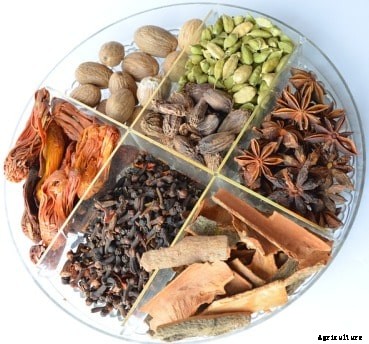 Anbaupraktiken von Gewürzen.
Anbaupraktiken von Gewürzen.
Von Gewürzen wird erwartet, dass sie Kalorien enthalten, Portion Fett, Kohlenhydrate, Mineralien, Mikronährstoffe und Proteine. Kreuzkümmel und Ingwer weisen eine hohe antioxidative Eigenschaft auf, die als natürliche Konservierungsstoffe hilfreich ist.
Gewürze werden durch ein Bakterium namens Salmonellen kontaminiert. Einige dieser Bakterien sind gegen Antibiotika resistent und werden jetzt mit der Strahlensterilisationsmethode behandelt.
KURKUMA GEWÜRZBAU:
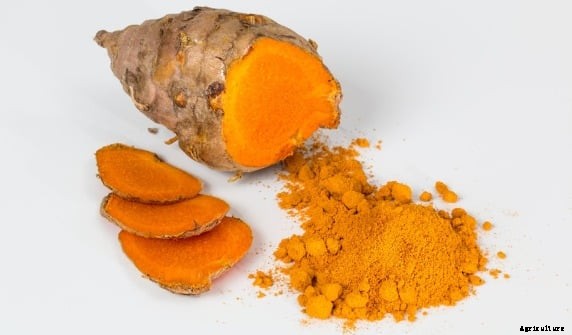 Kurkuma.
Kurkuma. - EINLEITUNG: Der binomiale Name für Kurkuma ist Curcuma longa und gehört zur Familie der Ingwergewächse. Er gilt als der Ureinwohner des indischen Subkontinents. Dies ist ein Rhizom, das in trockener Pulverform verwendet wird. Es hat medizinische Eigenschaften und wird daher für antibakterielle Behandlungen verwendet. Es ist gelb in der Farbe und hat ein schönes Aroma.
- BODEN- UND KLIMABEDINGUNGEN FÜR DEN GEWÜRZBAU VON KURKUMA: Für den Kurkuma-Anbau werden sandige und tonige Lehmböden mit hohem Humusgehalt und guter Drainage verwendet. Es wird auf Meereshöhe oder an einem angebaut Höhe von 1500 m Über dem Meeresspiegel. Die Temperatur der Region wird auf geschätzt 20-30 Grad Celsius und der Durchschnitt Niederschlag sollte etwa 1500-2250 mm . betragen
- VERMEHRUNG: Kurkuma wird durch Rhizomstecklinge vermehrt, die während der späten Wintersaison gepflanzt werden.
- LANDVORBEREITUNG UND PFLANZEN: Gruben von 3 Zoll Tiefe werden mit einer Handhacke hergestellt und die Reihenabstand beträgt 25 cm x 30 cm . Diese werden mit Erde und trockenem Viehmist bedeckt. Grate und Furchen sind in einem Abstand voneinander Reihenabstand 45-60 cm und im Abstand von 25 cm für Pflanzen.
- DÄNGEN UND BEWÄSSERUNG: Rindermist mit 40 Tonnen/ha wird in großem Umfang für die Kurkuma-Landwirtschaft verwendet. Da es sich bei dieser Pflanze um einen Bewässerungstyp handelt, Es benötigt 15-20 Zyklen für schwere Böden und 35-40 Zyklen für leichte Böden. FYM @10 Tonnen/ha wird für die Grundversorgung benötigt. Die Ration von N:P:K ist 125:37:37 kg/ha.
- Das Mulchen erfolgt zweimal mit Zuckerrohrabfall oder Grün Blätter @ 12-15 t/ha im Abstand von 50 Tagen.
- KRANKHEITSMANAGEMENT: Shoot Borer wird kontrolliert von Sprühen von 0,1% Malathion . Die Rhizomskala wird kontrolliert, indem die Rhizome vor dem Pflanzen in Chinalphos 0,1% getaucht werden. Die Rhizomfäule wird durch die Verwendung von . kontrolliert Dithan M-45 0,3% bei der Bodenvorbereitung. Blattfleckenkrankheit wird kontrolliert durch Sprühen von 0,2% Dithan M-45 .
- ERNTE UND VERARBEITUNG: Die Ernte erfolgt 10 Monate nach dem Pflanzen, wenn das Rhizom reif ist. Warmes Wetter ist gut für Kurkuma, wenn sie im Oktober gesät wird, wird sie im August geerntet. Rhizome werden weich gekocht und in der Sonne auf Bambusmatten für ungefähr 15 Tage getrocknet.
- ERTRAG: Im Durchschnitt liefert ein Morgen Land 8-10 Tonnen Kurkuma.
LACHBLATT GEWÜRZBAU:
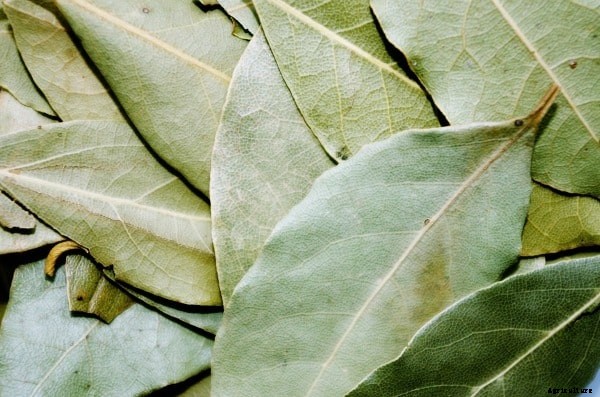 Lorbeerblatt.
Lorbeerblatt. - EINLEITUNG: Lorbeerblatt (binomialer Name:Laurus nobilis). Er stammt aus dem Mittelmeerraum und wird bis zu 40 Fuß hoch. Die Pflanzen haben mittelgroße grüne Blätter. Es wird sowohl als Aromastoff als auch als Medizin verwendet.
- BODEN- UND KLIMABEDINGUNGEN FÜR DEN GEWÜRZBAU VON BUCHBLÄTTERN: Sonnenlicht ist eine Selbstverständlichkeit und kalter Wind oder Frost können schädlich sein. Das günstige Klima ist warmes und feuchtes Mittelmeerklima. Gut durchlässiger Boden mit ausreichend organischer Substanz ist sehr gut geeignet mit A pH-Bereich von 6-8.
- VERMEHRUNG: Zur Vermehrung von Lorbeer werden geschichtete Triebe oder Wurzelstecklinge verwendet.
- LANDVORBEREITUNG UND PFLANZEN: Das Land wird mit Hofdünger ergänzt und das Unkraut durch Pflügen entfernt.
- DÄNGEN UND BEWÄSSERUNG: Verfaulter Hofdünger ist hilfreich, um den Bodenreichtum zu verbessern. Durch Tropfbewässerung wird für eine ausreichende Wasserversorgung gesorgt, um die Bodenfeuchtigkeit intakt zu halten.
- KRANKHEITSMANAGEMENT: Milben, Blattläuse und harte Schuppen sind Schädlinge, die den Baum befallen und durch die Anwendung von Neemöl bekämpft werden. Schwefelspray verhindert schwarze Flecken und Blattschäden.
- ERNTE UND VERARBEITUNG: Da es sich um eine immergrüne Sorte handelt, die Blätter stehen das ganze Jahr über zur Ernte bereit. In der Regel sind sie vor Gebrauch trocken.
- ERTRAG: Ein Hektar Land produziert 6 Tonnen Blätter.
NUTMEG UND MACE GEWÜRZBAU:
- EINLEITUNG: Muskat und Muskatblüte sind die Produkte desselben Baumes (botanischer Name:Myristica fragrans houtt). Dieser Baum stammt aus Indonesien und wird heute in einigen Teilen Indiens angebaut. Es ist ein immergrüner Baum, der dicht belaubt ist und bis zu 20 m hoch wird. Diese Gewürze werden zum Aromatisieren von Lebensmitteln verwendet. Parfums, Zubereitung von Ölen und Butter.
- BODEN- UND KLIMABEDINGUNGEN FÜR DEN NUTMEG-GEWÜRZBAU: warm, feuchtes Klima mit einem jährlichen Niederschlag von 150 cm wird für diese Bäume benötigt. Das ideale Gebiet ist vom Meeresspiegel bis 1300 m Über dem Meeresspiegel. Die Hänge der westlichen und östlichen Ghats sind eine gute Wahl für die Muskat- und Streitkolbenzucht. Erde mit Lehm, Lehm, Sand und roter Laterit ist für diesen Baum geeignet.
- VERMEHRUNG: Die Samen der Früchte dieses Baumes werden zur Vermehrung verwendet. Luftschichtung und Knospung sind ebenfalls erfolgreiche Methoden zur Vermehrung, aber die technik von „Epikotyl-Pfropfen“ ist am produktivsten.
- LANDVORBEREITUNG UND PFLANZEN: wenn die Sämlinge wachsen, nach 12 bis 18 Monate sie werden in den Hauptbereich verpflanzt. Kubische Gruben mit einer Größe von 60 cm werden ausgehoben und mit Muttererde und Kompost gefüllt. Der Abstand zwischen den Gruben beträgt 8m x 8m² . Die Aussaat erfolgt während der Regenzeit. In den ersten Jahren ist Schatten erforderlich. Das Mulchen erfolgt mit Müll, der in der Umgebung vorhanden ist.
- DÄNGEN UND BEWÄSSERUNG: Der Baum benötigt viel Dünger für mehr Ertrag und Wachstum. FYM @ 10 kg/Pflanze wird im ersten Jahr verwendet. Ein 15 Jahre alter Baum würde etwa 50 kg Dung benötigen. Stickstoff @ 20 Gramm, Phosphor @ 18 Gramm und Kali @ 50 Gramm werden auf jede Pflanze im ersten Jahr aufgetragen. Die Dosis steigt mit dem Alter des Baumes und wird zweimal im Jahr angewendet; Mai-Juni und September-Oktober. Bewässerung ist nicht stark erforderlich.
- KRANKHEITSMANAGEMENT: Das durch diplodianatalensis verursachte Absterben wird durch Auftragen von Bordeaux-Mischung auf das Ende der Zweige kontrolliert. Fadenlicht wird durch Marasmius sp. wird durch Aufsprühen von 1% Bordeaux-Mischung kontrolliert. Fruchtfäule wird durch Phytophthora und Diplodia natalensis verursacht, die durch Sprühen bekämpft wird 1% von Bordeaux
- ERNTE UND VERARBEITUNG: Wenn Sämlinge verwendet werden, beginnt die Lagerung in 7-8 Jahren, aber wenn die Transplantation durchgeführt wird, beginnt das Tragen in 4-5 Jahren. Die volle Tragfähigkeit wird nach 15-20 Jahren erreicht und ergibt bis zu 60 Jahre. Geerntet wird von Juni bis August. Die Reifung der Frucht ist bekannt, wenn die fleischige Rinde aufplatzt. Die Muskatblüte wird von der Nuss getrennt und langsam 10-15 Tage in der Sonne getrocknet. Das Saatgut wird auch separat für 4-8 Wochen in der Sonne oder durch künstliche Verfahren getrocknet. Die äußere Hülle wird entfernt und die Mutter wird herausgenommen.
- ERTRAG: Der durchschnittliche Ertrag eines einzelnen Baumes beträgt 2000-3000 Früchte pro Jahr. Es wird erwartet, dass ein Hektar Land 800 kg Muskatnuss und 100 kg Muskatblüte produzieren kann.
STERNANIS GEWÜRZBAU:
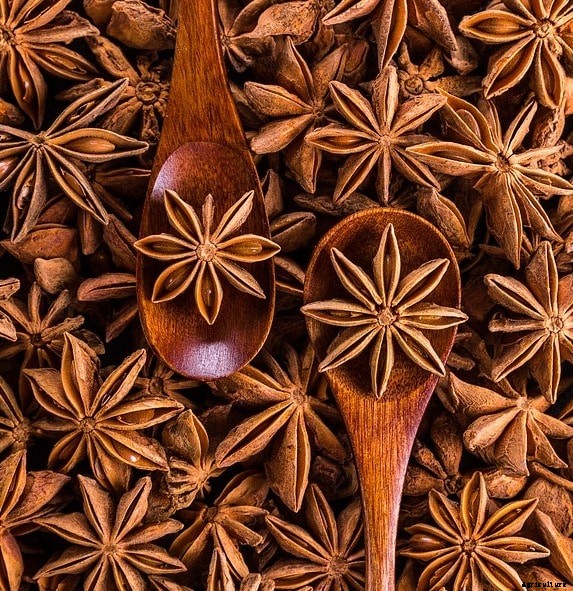 Sternanis.
Sternanis. - EINLEITUNG: Dieses Gewürz hat seinen Namen von der Form. Sein botanischer Name ist Illicium verum. Sibirien gilt als ideal für den Anisanbau. Dies ist ein dunkelbraunes Gewürz mit starkem Aroma. Dieser wird auch als Anis bezeichnet und hat medizinische Eigenschaften. Es ist ein immergrüner Baum und wird 5-10 m hoch.
- BODEN- UND KLIMABEDINGUNGEN FÜR DEN STERNANIS-GEWÜRZBAU: Humusreicher Boden oder leicht saurer Boden eignet sich am besten für den Anisanbau. Erfordert subtropisches Klima mit einer Temperatur von nicht weniger als -10 Grad Celsius. Die Pflanze braucht ein warmes, sonniges Klima, in dem es keine trockenen oder kalten Winde gibt. Der pH-Wert des Bodens beträgt 6-6,7.
- VERMEHRUNG: Die Vermehrung erfolgt durch direkte Aussaat von Samen oder Stecklingen. Die Temperatur für die Vermehrung beträgt 18-20 Grad Celsius.
- LANDVORBEREITUNG UND PFLANZEN: 6 Wochen alte Sämlinge werden im Abstand von . ausgesät 12 Zoll . Jede Reihe ist getrennt von 18-24 Zoll . Die Aussaat erfolgt im Frühjahr.
- DÄNGEN UND BEWÄSSERUNG: Eine ausreichende Feuchtigkeitsversorgung ist ausreichend. Im Winter ist nur sehr wenig Bewässerung erforderlich. Das Verteilen einer 3-Zoll-Kompostschicht um den Baum ist der beste Dünger. Manchmal für höhere Ausbeute und Qualität ein synthetisches NPK-Dünger oder Bactofil B-10 und slavol (Biodünger) verwendet.
- KRANKHEITSMANAGEMENT: da es sich um eine antibakterielle und schädlingsabweisende Sorte handelt, Es ist also nicht viel erforderlich, um bei diesen Pflanzen eine Krankheit zu bekämpfen.
- ERNTE UND VERARBEITUNG: Der Baum braucht 6 Jahre, um Früchte zu tragen, wenn er aus Samen gezogen wird. Die Früchte werden reif gepflückt und in der Sonne getrocknet, bis sie ihre Farbe von grün nach rotbraun ändern.
- ERTRAG: Unter günstigen Bedingungen beträgt der durchschnittliche Fruchtertrag dieses Baumes 1551 kg/ha.
MEHR KARDAMOM-GEWÜRZBAU:
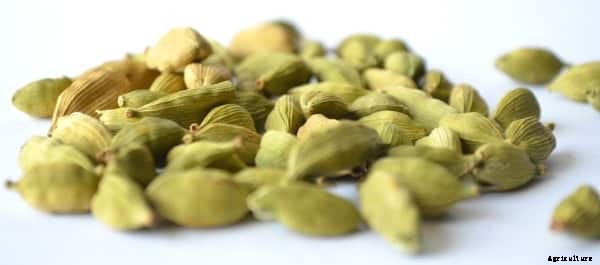 Kardamom.
Kardamom. - EINLEITUNG: Dies wird auch schwarzer Kardamom genannt und sein binomialer Name ist Amomum subulatum. Die Schoten haben ein starkes Raucharoma und werden als Gewürz verwendet. Die größten Produkte stammen aus Nepal. Es hat auch medizinische Anwendungen wie die Behandlung von Gelbsucht.
- BODEN- UND KLIMABEDINGUNGEN: Dieses Gewürz wird in Höhen von angebaut 1000-2000 über dem mittleren Meeresspiegel. Es erfordert eine jährliche durchschnittliche Niederschlagsmenge von 3000-3500 mm . Tief, Gut durchlässiger Lehmboden ist gut für diese Pflanzen. Der pH-Wert des Bodens soll gehalten werden bei 4,5-6.
- VERMEHRUNG: Die Vermehrung dieser Pflanze erfolgt vegetativ durch Rhizome oder durch Samen. Rhizome aus gewachsenen Pflanzen werden entnommen und zu kleineren Klumpen verarbeitet und in Gruben gepflanzt.
- LANDVORBEREITUNG UND PFLANZEN: Für den Anbau dieser Pflanze wird ein mäßiges Gefälle in Betracht gezogen. Gruben von Abmessungen 30 x 30 x 30 cm werden im Abstand von gegraben 5 x 1,5 m zwischen jeder Grube während des Monsuns. Die Gruben sind mit Mutterboden und Kompost bedeckt. Setzlinge werden in die Mitte der Grube gepflanzt und das Mulchen erfolgt mit trockenen Blättern an der Basis der Pflanze.
- DÄNGEN UND BEWÄSSERUNG: Rindermist und nicht essbare Ölkuchen, wie sie als Dung verwendet werden. Bessere Bewässerung führt zu höheren Erträgen. Je nach Bedarf kommt eine Sprinklerbewässerung zum Einsatz.
- KRANKHEITSMANAGEMENT: Bei dieser Pflanze können Pilz- und Bakterienkrankheiten auftreten. Die beiden größten Bedrohungen für diese Pflanze sind Chirke und Foorkey.
- ERNTE UND VERARBEITUNG: wenn der Samen einer Kapsel braun wird, die Fräsen sind 30-35 cm geschnitten und dürfen reifen 10-15 mehr Die Ernte erfolgt durch eine Ausrüstung namens ‘ Elaichihurri’ und die Spitzen sind gehäuft. Die Kapseln werden getrennt und getrocknet. Der Kelch wird durch Reiben der Kapsel an einem Draht entfernt.
- ERTRAG: Schätzungen zufolge erzeugt ein Hektar Land 2000 kg trockenen Kardamom.
GEWÜRZBAU MIT WENIGER KARDAMOM:
- EINLEITUNG: Dieses Gewürz stammt aus dem indischen Subkontinent und ist das am meisten benötigte Gewürz in der gesamten Liste. Es ist eine immergrüne Pflanze, die in den Western Ghats vorkommt. Der binomische Name dieses Gewürzes ist Elettaria Cardamomum L. Die maximale Höhe dieser Pflanze beträgt 2-4 Meter und die in Indien vorkommenden Sorten sind Mysore, Malabar- und Vazhukka-Typ.
- BODEN- UND KLIMABEDINGUNGEN FÜR DEN KARDAMOM-GEWÜRZBAU: Die optimale Temperatur und Regenmenge, die für den Anbau von weniger Kardamomgewürzen erforderlich sind, beträgt ein 10-35 Grad Celsius und 1500-4000 mm Jahresniederschlag bzw. Schwarzer Lehmboden mit reichem Humus vor allem im Waldgürtel eignet sich am besten für den Anbau dieses Gewürzes. Sandiger Boden wird überhaupt nicht bevorzugt.
- VERMEHRUNG: Zur Vermehrung werden Samen oder Saugnäpfe verwendet. Diese Samen werden in Baumschulen gezüchtet und unter geeigneten Bedingungen im Hauptbereich gepflanzt.
- LANDVORBEREITUNG UND PFLANZEN: 45 cm x 45 cm x 30 cm Gruben werden von April bis Mai ausgehoben und mit Kompost und Muttererde gefüllt. Die Bepflanzung erfolgt entlang der Konturen eines Hanges mit einem Abstand von 2m x 1m² . Der Beginn des Monsuns ist ideal für die Aussaat dieser Samen und sie werden im Sommer im Abstand von . in die Hauptfläche verpflanzt 20cm x20cm . Schatten ist vorhanden und Wasser wird regelmäßig geliefert.
- DÄNGEN UND BEWÄSSERUNG: Stickstoff @90 Gramm, Phosphor @60 Gramm und Kali @ 120 Gramm werden für eine Bettgröße von 5 m x 1 m benötigt. Diese Dosis wird in drei Raten im Abstand von jeweils 45 Tagen verabreicht. Der für diese Kultur verwendete Düngergehalt beträgt Stickstoff @ 75 kg, Phosphor @75 kg und Kali @150 kg pro Hektar wenn es von externen Quellen bewässert wird, wenn die Felder aber durch Regen bewässert werden, beträgt die Düngemenge 30:60:30 kg/ha. Der Gesamtdünger wird geteilt und zweimal ausgebracht:einmal im Mai und einmal im September. 30 cm um die Pflanze herum werden die Düngemittel ausgebracht. Während der Rispenbildung ist eine Bewässerung dringend erforderlich, Blüte und Fruchtbildung. Bis zum Eintreffen des Monsuns erfolgt die Bewässerung im Abstand von 10-15 Tage.
- KRANKHEITSMANAGEMENT: Thripse und Sproßbohrer werden durch Sprühen von Monocrotophos 0,025% (März-September) bekämpft. Blattläuse werden durch Sprühen von 0,05% Dimethoat bekämpft. Parasitäre Nematoden werden durch Behandlung der Pflanzen mit Carbofuran 3 g @ 5 kg Wirkstoff/ha bekämpft. Kapselfäule wird durch Sprühen kontrolliert 1% Bordeaux Rhizomfäule wird durch die Behandlung des Bodens mit 0,2% Kupferoxychlorid .
- ERNTE UND VERARBEITUNG: Bereits nach zweijähriger Pflanzung beginnen die Pflanzen Früchte zu tragen. Die Ernte erfolgt von Oktober bis November. Die geernteten Früchte werden mit einem elektrischen Trockner bei einer Temperatur von . getrocknet 45-50 Grad für ungefähr 14-18 Stunden .
- ERTRAG: Es wird geschätzt, dass ein Hektar Land 1300 kg trockenen Kardamom produziert.
KORIANDER GEWÜRZBAU:
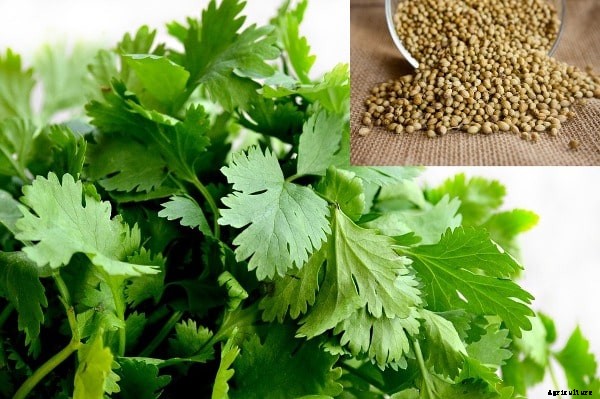 Koriander.
Koriander. - EINLEITUNG: Dies ist ein Kraut, das im Mittelmeerraum beheimatet ist. In Indien betreiben einige Bundesstaaten Korianderanbau, aber meistens ist es eher für den lokalen Gebrauch als für den Export bestimmt. In andere Länder wird sehr wenig exportiert. Der binomiale Name dieser Pflanze ist Coriandrum Sativum L. Sie ist wegen ihres Geschmacks und Aromas am begehrtesten. Sowohl die Blätter der Pflanze als auch die getrockneten Früchte werden zur Zubereitung von Speisen verwendet. Diese Kräuterpflanzen werden 30-70cm hoch. Es hat auch einige medizinische Anwendungen.
- BODEN- UND KLIMABEDINGUNGEN FÜR DEN GEWÜRZBAU VON KORIANDER: Diese Pflanze eignet sich für den ganzjährigen Anbau und ist eine tropische Sorte. Jeder Bodentyp mit reichhaltiger organischer Substanz ist für seine Kultivierung geeignet. Schwarzer Baumwollboden gilt als am besten bei ausreichendem Niederschlag.
- VERMEHRUNG: Die Vermehrung erfolgt durch Samen.
- LANDVORBEREITUNG UND PFLANZEN: Nach dem Einsetzen des Monsuns wird das Land 3-4 mal gepflügt und da es sich um eine Rabi-Kultur handelt, erfolgt die Aussaat im Oktober und November. Ein Hektar Land braucht 10-15 kg von Samen. Eine bessere Keimungstechnik ist das Einweichen der Samen in Wasser für 12-24 Stunden vor der Aussaat. Die Reihen in der Farm sind durch einen Abstand von . getrennt 30-40 cm² und maximale Tiefe beträgt 3 cm.
- DÄNGEN UND BEWÄSSERUNG : FYM @ 10 Tonnen/ha wird verwendet. NPK-Dünger @ 15 kg, 40kg und 20kg pro Hektar bzw, für bewässerte Pflanzen erforderlich ist, in der Erwägung, dass für regengefütterte Pflanzen NPK @ 20kg, 30kg, 20kg pro Hektar ist jeweils erforderlich. Während der gesamten Landwirtschaft sind 4-6 Bewässerungszyklen erforderlich. Jeder Bewässerungszyklus wird in einem Intervall von 30-35 Tagen durchgeführt.
- KRANKHEITSMANAGEMENT: Blattläuse werden durch die Sprühen von 0,3% Malathion, während die Cutworm mit 4% Endosulfanstaub bei 20-25 kg/ha bekämpft wird. Echter Mehltau und Welkekrankheit werden durch Besprühen mit nassem Schwefel bekämpft. Stammgalle wird kontrolliert unter Verwendung von 0,1 % Bavistin und die Krautfäule wird unter Verwendung von 0,2 % Mancozeb bekämpft.
- ERNTE UND VERARBEITUNG: Im Allgemeinen wird die Ernte innerhalb von 90-110 Tage . Der Farbwechsel der Früchte von grün nach braun zeigt den Erntezeitpunkt an.
- ERTRAG: Der Ertrag von regengefütterten Pflanzen beträgt 400-500 kg/ha und der von bewässerten Pflanzen 600-1200 kg/ha.
Bockshornklee-Gewürz-Anbau:
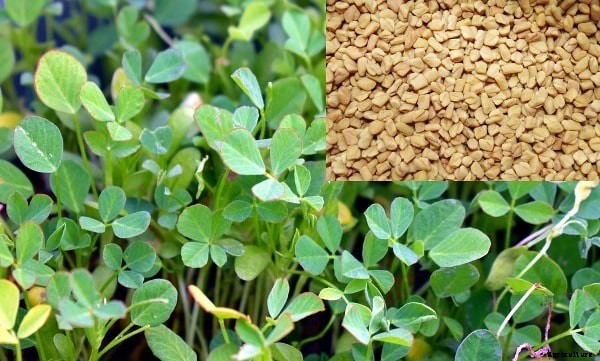 Bockshornklee.
Bockshornklee. - EINLEITUNG: Dieses Kraut stammt aus Osteuropa und Westasien. Die Blätter und Samen werden bei der Zubereitung von Speisen verwendet. Sein binomialer Name ist Trigonella Foenum-graecum L. Die maximale Höhe der Kultur beträgt 0,9 m. Es gibt zwei Hauptsorten von Kulturpflanzen, die angebaut werden:T. Foenum-graecum (Methi) und corniculata (kasuri methi).
- SOIL AND CLIMATE CONDITIONS FOR FENUGREEK SPICE FARMING: Both temperate and tropical climate are suitable for its cultivation. During seed germination temperature is being maintained around 8-27 degree Celsius. It can resist frost and extreme cold climate. Very low rainfall is required for this crop. Clayey loam is extremely good for these crops with a pH of 6-7
- PROPAGATION: Propagation is done by seeds. Seeds are soaked in warm water for 6-12 hours before sowing.
- LAND PREPARATION AND PLANTING: Ploughing is done thrice before sowing seeds and the soil beds are created uniformly with spacing between rows as 20-25 cm . In the plain area September to November is usually preferred for sowing the seeds, whereas in hilly areas the sowing is done in March.
- MANURING AND IRRIGATION: FYM @15 tonnes per hectare is used. NPK fertilizers @25 kg, 25 kg, 50 kg/ha respectively is required. Nitrogen is applied in two installments whereas the other two types of fertilizers are applied to the base of the crops at a time. 4-6 irrigation cycles are required during entire crop growth with an interval of 20-25 days between each cycle. Pre-irrigation is also done.
- DISEASE MANAGEMENT: root rot is caused by Rhizoctoni Solani and is controlled by drenching the soil with carbendazim 0.05%. Powdery mildew is controlled by spraying dinocap @20-25 grams/10 liters of water . Downy mildew is controlled by spraying 0.2% of difoltan solution.
- HARVESTING AND PROCESSING: Young shoots are removed within 25-30 days of sowing. The leaves are cut within 15 days of growth and minimum 2 cuttings are done before the flowering and fruit formation of the crop. The crops are removed when the pods dry and the entire thing is dried in the sun, which facilitates the removal of seeds by rubbing with the hands. Again the removed seeds are dried in the sun and packed.
- YIELD: One hectare of land produces 1200-1500 kg of seeds and 800-1000 kg of leaves.
ROSEMARY SPICE FARMING:
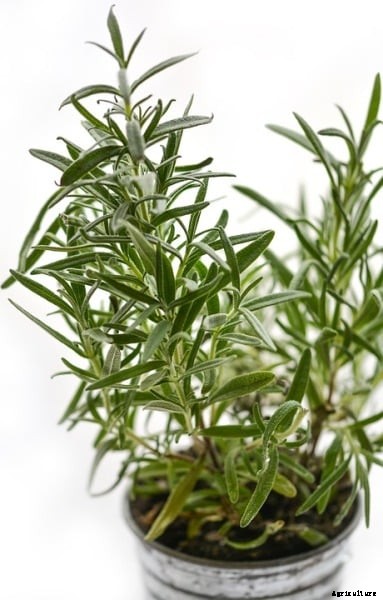 Rosemary.
Rosemary. - INTRODUCTION: Rosemary is a perennial herb and is evergreen in nature. It is a native of the Mediterranean region and its binomial name is Rosmarinus officinalis. The shrub has a maximum height of 1.5m. This crop is famous for its aroma; the leaves, twigs and flowers are used for various purposes.
- SOIL AND CLIMATE CONDITIONS FOR ROSEMARY SPICE FARMING: Well-drained lateritic soil is best for the cultivation of rosemary crops. The pH of the soil is maintained in-between 5.5-7. 20-30 degree Celsius is the ideal temperature for its growth. Average annual rainfall of 10-20 cm is required a nd an altitude of 2500 m above sea level is considered good for growing rosemary.
- PROPAGATION: Seeds are used for growing rosemary plants, but with extreme care and typical conditions. Also cuttings, roots and layering are sometimes used to grow rosemary.
- LAND PREPARATION AND PLANTING: Land to be used for cultivation is ploughed two times and neem care is mixed as a source of manure. The spacing between rows of rosemary plants have to be 40-50 cm and beds of width 1-2 m is created. Initially the cuttings are raised in the nursery and then shifted to main area during midsummer.
- MANURING AND IRRIGATION: FYM @ 50 tonnes/ha, neem cake@1 ton/ha, natural compost@ 5 tonnes/ha and vermicompost @5 tonnes /ha as applied at the base of the crop during initial planting. Subsequent year onwards 5-30 kg per hectare is applied.
- DISEASE MANAGEMENT: This shrub is resistant to pests and fungus.
- HARVESTING AND PROCESSING: When the flowering starts the plants can be harvested. From second year harvesting is done every four months. The leaves are cleaned thoroughly and dried in shade for 10-15 days .
- YIELD: one hectare of land annually produces 2.5 tonnes of dried leaves of rosemary.
CHILLIE SPICE FARMING:
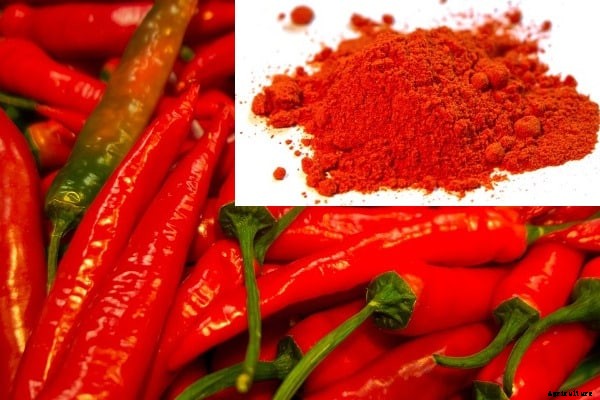 Chilli spice.
Chilli spice. - INTRODUCTION: very common and needed Indian spice is chilli. It originated from Mexico, but the largest producer of chillies Japan. It is both a spice and a vegetable variety. The binomial name of the chili is capsicum annuum. It is a shrub
- SOIL AND CLIMATE CONDITIONS FOR CHILLIE SPICE FARMING: It needs warm, humid and dry weather. Temperature ranges from 20-25 degree Celsius . Temperatures beyond 35 degree effect the fruit development. Very little moisture is required to grow chillies. Well-drained sandy loam soil having high organic content is useful for growing chillies. The pH of the soil should be in-between 5-7.5. 2100 meters above mean sea level is the altitude up to which chillies can be grown.
- PROPAGATION: chilli propagates through seeds.
- LAND PREPARATION AND PLANTING: 2-3 ploughings are given to the soil before sowing seeds. Before sowing the soil is sterilized to make it free from fungus and other infections. Seeds are initially planted in nurseries and then transplanted to the main area. Coco peat is used to cover the soil with seeds and is lightly watered until seedling stage. The crop distance is 45 cm x 45 cm in the main area. Ridges and furrows of dimensions 60 x 45 cm is maintained for intercropping. Each raised bed of chilli is dimensioned as 30 x 120 cm .
- MANURING AND IRRIGATION: These plants do not require much water. Irrigation is done only when the moisture content of water drops to less than 25%. 1 kg of azospirillum with 50 g of FYM is used as manure.
- DISEASE MANAGEMENT: White ants are treated using 8-10 aldrin/acre. Fruit rot, die back, verwelken, Mehltau, leaf spot is treated with 1% Bordeaux mixture. Neem cake @100 kg is used to destroy grubs.
- HARVESTING AND PROCESSING: Harvesting is done at regular intervals. They are dried in shade for 2-3 days.
- YIELD: One acre of land produces 30-40 quintals of fresh chillies and of which 25-35 kg of dried chillies is obtained from every 100 kg of fresh chillies.
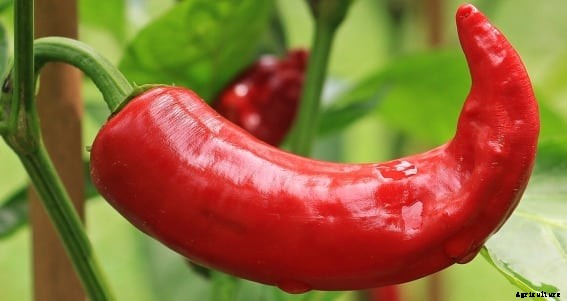 Red Chilli.
Red Chilli.
CELERY SPICE FARMING:
- INTRODUCTION: The binomial name of celery is apium graveolens. It is an herb used for various purposes. The height of the herb is 10-14 inches and has white colored flowers. It is a native of the Mediterranean region.
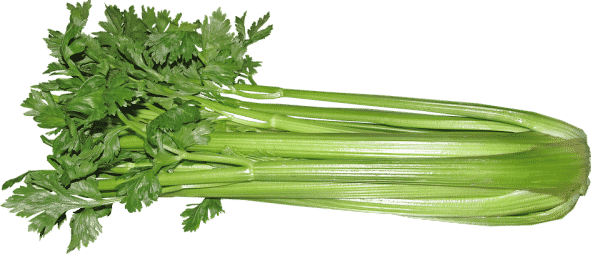 Celery.
Celery. - SOIL AND CLIMATE CONDITIONS FOR CELERY SPICE FARMING: During the growing stage it needs cold climate and during maturing it needs warm climate. A well drained loamy soil is considered good for this herb. The min temperature requirements are 12-30 degree Celsius with an average rainfall of 100 cm. The pH of the soil is maintained at 5.6 for good produce.
- PROPAGATION: propagation is done using seeds which are initially raised in a nursery and then transplanted to the main area.
- LAND PREPARATION AND PLANTING: Land is ploughed four to five times before planting. The spacing of these celery plants is 45 cm x 25 cm and the sowing depth is 2-4 cm. The seeds take 4-8 weeks for seedling and after 2 months, transplanted to the main area. November is the best time for sowing seeds.
- MANURING AND IRRIGATION: FYM @ 20-25 tonnes are used zusammen mit nitrogen @200 kg, phosphorous @100 kg and potash @150 kg per hectare is required. Irrigation is highly essential and is given at an interval of 10-15 days.
- DISEASE MANAGEMENT: Damping –off, Fusarium yellows, early blight downy mildew is controlled by drenching the land with 400 grams of copper Oxy chloride .
- HARVESTING AND PROCESSING: 4-5 months after sowing, the crops are harvested.
- YIELD: one hectare of land yields about 25-30 tonnes of celery.
CUMIN SPICE FARMING:
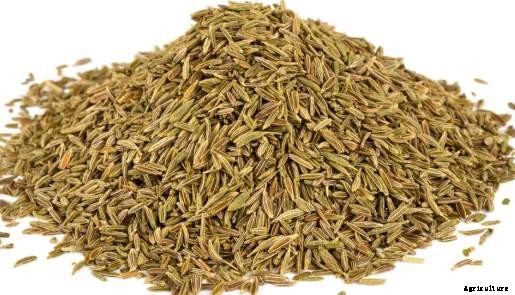 Cumin Seeds.
Cumin Seeds. - INTRODUCTION: This is a flowering plant and native to the Middle East and India. Its binomial name is Cuminium Cyminum. Cumin is a herbaceous plant whose seeds is dried and used as spice. The height of this plant is 30-50cm. In Hindi it is addressed as jeera which is most famous and widely used spice in Indian cuisines.
- SOIL AND CLIMATE CONDITIONS FOR CUMIN SPICE FARMING: Sandy loam soil with high nutrient content is required for the cultivation of cumin. The soil should be well drained and should be able to hold moisture. Mild climate is required for its cultivation and winter weather is also suitable. Sunlight is highly essential for its growth.
- PROPAGATION: seeds are used for propagation.
- LAND PREPARATION AND PLANTING: sowing of cumin seeds is done in December and the rows are spaced 30 cm apart.
- MANURING AND IRRIGATION: FYM @ 12-15 tonnes/ha zusammen mit phosphorus @20 kg, nitrogen @30 kg is applied to the soil. These fertilizers are applied in two splits. Initially the seedlings are lightly watered and the second irrigation is done after 7-10 days.
- DISEASE MANAGEMENT: Powdery mildew is controlled by spraying 20-25 grams /10 liters of water. Ähnlich, Alternaria blight is controlled by spraying 0.2% of dinocap.
- HARVESTING AND PROCESSING: Complete maturity in plants is obtained within 100-115 days from sowing. Harvesting is done by uprooting the entire plant and drying it. The dried plants are thrashed to remove seeds.
- YIELD: An average yield is 5 quintals per hectare.
GINGER SPICE FARMING:
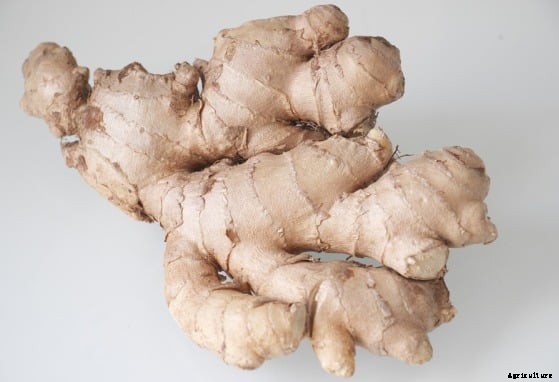 Ginger root.
Ginger root. - INTRODUCTION: This spice is native to Asia and has high demand locally and internationally. It is an herb which grows to a height of 1 m and bears yellow flowers. This spice has many medicinal properties and refreshing aroma.
- SOIL AND CLIMATE CONDITIONS FOR GINGER SPICE FARMING: Warm, humid climate is favorable for the growth of ginger. An altitude of 1400-1500 m is suitable for cultivation. This herb is grown in different soils. The pH of the soil should be 5-6.5.
- PROPAGATION: Propagation is done using rhizomes. The length of the rhizome should be 5-5 cm and should weight 20-25 grams .
- LAND PREPARATION AND PLANTING: 3-4 ploughings of land are done during summer. Crosswise harrowing is done to make the soil loose. A bed for the crops is made 1 m wide, 15 cm high . Each bed is separated by 50 cm. solarisation is done using polyethylene sheets for 40-45 days.
- MANURING AND IRRIGATION: FYM @ 15 tonnes/ha along with NPK @60 kg, 50 kg, 50 kg / ha respectively is used for growing these crops. Irrigation is provided at an interval of 8-10 days. Maximum 20 irrigation cycles are needed for the entire growing period. Drip irrigation is also preferred.
- DISEASE MANAGEMENT: Shoot borer is controlled by spraying 0.1% of Malathion. Rhizome flies are controlled by spraying 05% methyl parathion . Leaf roller and scales are controlled by spraying 0.05% dimethoate . Soft rot is controlled by captafol 0.1%. Leaf spot is controlled by a 1 % Bordeaux mixture . Root knot nematode is controlled by solarising. Bacterial wilt is controlled by spraying 200 ppm streptocycline .
- HARVESTING AND PROCESSING: Green ginger can be harvested in 215-220 days after planting the rhizomes. Yellowing of leaves indicates the harvesting season.
- YIELD: One hectare of land produces 10-15 tonnes of green ginger.
THYME SPICE FARMING:
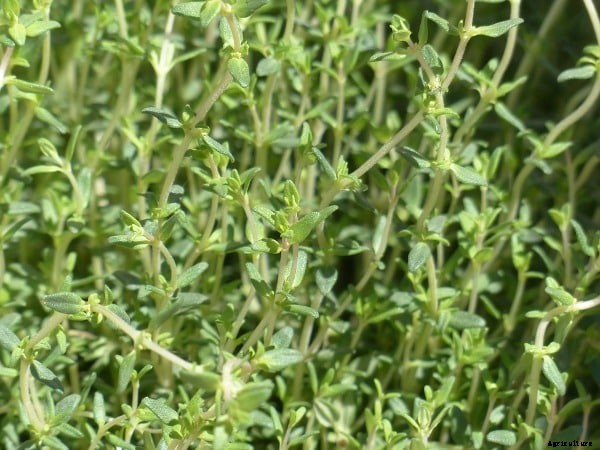 Thyme herb.
Thyme herb. - INTRODUCTION: This is an evergreen herb with aroma, generally used for cooking and medicinal purposes. It originated from the Europe and spread throughout the world through Romans.
- SOIL AND CLIMATE CONDITIONS FOR THYME SPICE FARMING: Requires well drained, fertile soil. Warm climate is suited for thyme plants and hill regions are considered best for cultivation.
- PROPAGATION: It is propagated through seeds and also vegetatively by plants.
- LAND PREPARATION AND PLANTING: ploughing is highly essential to prepare the land and plants are planted 15-30 cm apart. The spacing between the rows is 60 cm.
- MANURING AND IRRIGATION: FYM @ 50 tonnes/ha, vermicompost @ 5 tonnes/ha, neem cake @1.25 kg/ha, azospirillum and phosphobacterium and panchagavya is sprayed @3%.
- DISEASE MANAGEMENT: No major diseases occur to this plant.
- HARVESTING AND PROCESSING: For cooking purposes leaves and flowers are used. Harvesting starts from 4-5 months of sowing. The shoots are cut from the plant with a length of 15 cm. When the leaves dry, they curl and turn brown.
- YIELD: one hectare of land yield 1100-2200 kg of thyme.
CLOVE SPICE FARMING:
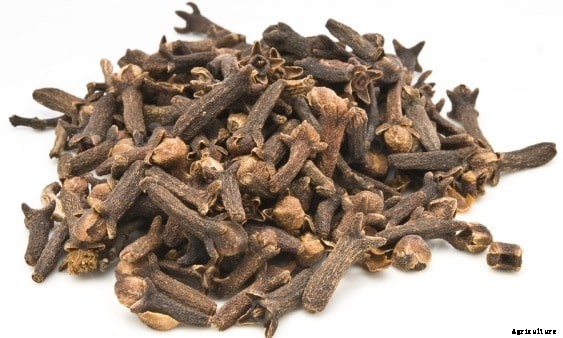 Cloves.
Cloves. - INTRODUCTION: Clove is an evergreen tree with high medicinal properties. The binomial name is Eugenia caryophyllus and is native to the Indonesian island. This plant grows to a height of 7-15 m. The dry unopened flower bud of the plant is the clove. In India the Western Ghats are popular for clove cultivation.
- SOIL AND CLIMATE CONDITIONS FOR CLOVE SPICE FARMING: This plant requires a warm, humid climate of temperature 20-30 degree Celsius and an average rainfall of 150-250 cm . The altitude is generally estimated to be 1500 m above mean sea level. Black loamy soil with rich humus is well suited for clove cultivation. Sometimes it is also grown in clay loam and laterite soil.
- PROPAGATION: Seeds are used for the propagation of clove usually during June to October. The seeds are soaked in water before sowing.
- LAND PREPARATION AND PLANTING: Pits of dimensions 60 cm x 75 cm x 3 cm are dug with a spacing of 6-7 m and filled with topsoil. Planting of seeds is done at the end of the monsoon.
- MANURING AND IRRIGATION: Rotten cattle manure @15 kg is required initially, but as the plants grow, they need more manure. The manure is applied basally at a radius of 5 m from the tree. Pot watering is required if there is no sufficient water supply. Plants need subsoil irrigation during peak summer season.
- DISEASE MANAGEMENT:
- HARVESTING AND PROCESSING: yielding starts during 7 years, but to attain full bearing the tree takes 15-20 years . After flowering the buds take 4-6 months for harvesting. The buds are dried for 4-5 days.
- YIELD: One fully grown tree gives 4-8 kg of dried buds.
FENNEL SPICE FARMING:
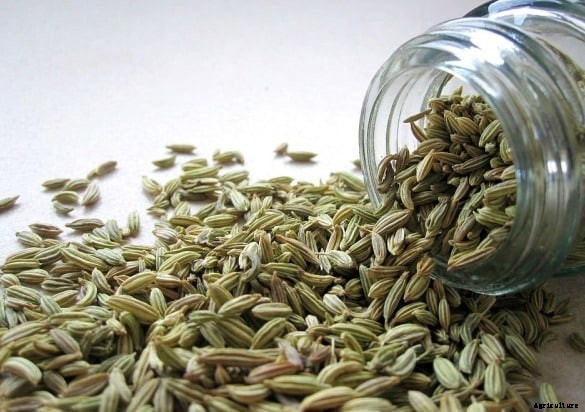 Fennel.
Fennel. - INTRODUCTION: It is a flowering plant and native to the Mediterranean. This spice has an exclusive aroma and a different flavor. This herbaceous plant grows to a height of 2.5 m. The binomial name is Foeniculum Vulgare. In India it is addressed as Saunf in Hindi.
- SOIL AND CLIMATE CONDITIONS: Every kind of soil is suitable for the cultivation of fennel. But well drained sandy or loamy soil is best suited with a pH of 6.5-8. The optimum temperature for the cultivation of these crops is 15-25 degree Celsius with an average rainfall of 50-75mm .
- PROPAGATION: It is not a transplanting variety. Propagation is done through seeds directly sowed in the main area.
- LAND PREPARATION AND PLANTING: The land is ploughed two three times to prepare a fine seed bed. This plant is rarely raised in nurseries. Sowing is done during October and if it is a rain fed region, then spacing of 45 cm between rows with 10 cm crop spacing is maintained.
- MANURING AND IRRIGATION: Cow dung@4-6qtl/acre along with urea@45 kg/acre i s applied three times in equally split proportions. Pre-sowing irrigation is done and then at an interval of 10-15 days 10-12 cycles of irrigation is required during the entire duration of cropping.
- DISEASE MANAGEMENT: Aphids are controlled by spraying 0.03% of dimethoate . Seed midge and heliothis is controlled by spraying 0.07% of endosulphan .
- HARVESTING AND PROCESSING: Maturity of plants is known when seeds are full and green in color. The umbels are cut and dried in the sun for 2 days and then dried in the shade for 10 days. The crop harvesting is done in May i.e. after 180 days from sowing.
- YIELD:O ne hectare of land yields 10-11 quintals of fennel on an average.
BLACK PEPPER SPICE FARMING:
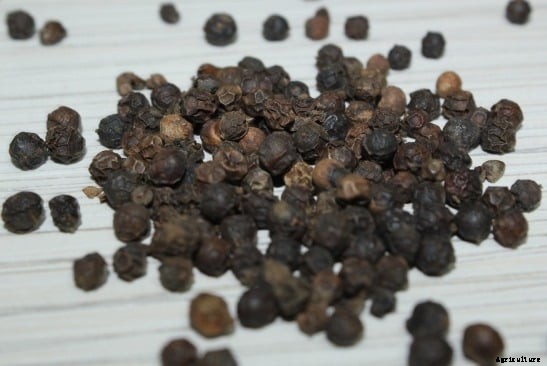 Black Pepper.
Black Pepper. - INTRODUCTION: The binomial name of black pepper is ‘piper nigrum’ and it is an evergreen flowering vine. This plant in mostly found in south India and grows to a height of 10 m. This is the earliest form of spice in India. There are 75 cultivars of pepper in India of which Karimunda is most popular. Other varieties are kottanadan, narayakkodi, aimpiriyan, kuthiravally, balancotta, kalluvally, malligesara and uddagare.
- SOIL AND CLIMATE CONDITIONS FOR BLACK PEPPER SPICE FARMING: pepper plants require tropical humid climate with sufficient rainfall (125-200 cm). The submountaeous region of Western Ghats is exclusive for growth of pepper plants. Clay loam, red loam and lateritic soils are suitable for pepper farming. The pH value of the soil is maintained at 4.5-6.0. The temperature should be in between 10-40 degree Celsius.
- PROPAGATION: Cutting from runner shoots is used for propagation of pepper. One third of the root is cut and planted in the nursery. They are obtained in the month of February –March. Roots develop from the cuttings and they are set for planting.
- LAND PREPARATION AND PLANTING: level land with proper drainage is chosen for farming. South facing slopes are avoided, but north or north eastern slopes are preferred to avoid the effect of the sun. Planting is done in the monsoon. Square pits of dimensions 0.5 m x 0.5 m are dug and the spacing between the pits is 2.5 m x 2.5 m . Seedlings which are two years old are planted in the pits. When the vine grows, it is initially made to creep on a pole of 2 m height. After a certain length the temporary stake is removed and planted in a trench of depth and width equal to 15 cm close to the tree trunk.
- MANURING AND IRRIGATION: Rotten cattle manure@ 10 kg is used as manure for pepper plants. 100 grams of nitrogen, 40 grams of P2O5 and 140 grams of K2O is used as a fertilizer for three year old plants. 1/3
rd
of the above mentioned composition is applied in the first year and 2/3rd of the quantity is applied in the second year. Lime @500 grams is applied as fertilizer during later stages of development.
- HARVESTING AND PROCESSING: Yield starts after 3 or 4 years from planting. The ripening takes 6-8 months from flowering and harvesting is done during November till February. The entire spike is plucked when the berries turn bright red. The spike is rubbed with hands to remove the berries which are then dried in the sun for 7 to 10 days until the berries turn black.
- YIELD: 800-1000 kg of black pepper is obtained from one hectare of plantation land (7-8 yrs old). The yield reduces after every 20-25 years.
CINNAMON SPICE FARMING:
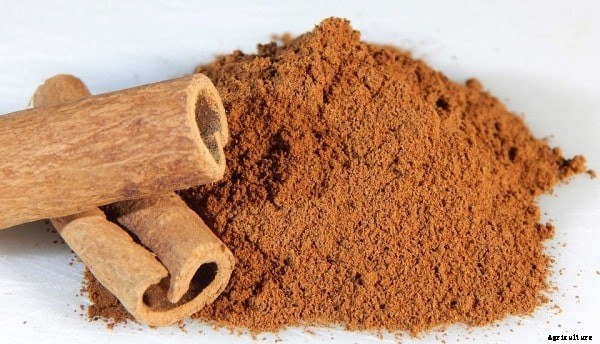 Cinnamon spice.
Cinnamon spice. - INTRODUCTION: Cinnamon is the inner bark of the tree and is the first known spice with rich flavour. It is native to Sri Lanka. Also lower slopes of Western Ghats (Kerala and Tamilnadu) cinnamon cultivation are predominant. Binomial name is Cinnamomum Cassia.
- SOIL AND CLIMATE CONDITIONS FOR CINNAMON SPICE FARMING: lateritic and sandy soil is preferred for cinnamon plant. The elevation of land above sea level is approximately 1000 m . This plant requires an annual rainfall of 200-250 cm .
- PROPAGATION :Cinnamon is propagated by rooted cuttings, air layering and seeds. 10 cm long with 2 leaves semi hardwood cuttings are dipped in keradix-B and planted in a polythene bag consisting of sand and coir dust mixture in the ratio 1:1. These are watered twice in a day and stored in the shade. Nach 45-60 days the roots develop indicating that it can be transplanted to a another permanent place
- A ring from the semi hardwood bark is removed and IBA 2000 ppm is applied on it. This region is covered with coir husk and wrapped with 20 cm of polythene. Rooting starts after 40-60 days and the air layers are detached from the parent plant. These can be planted in the main area during monsoon
- For the sowing of seeds a mixture of sand, soil and rotten cattle manure in the ratio 3:3:1 is prepared and germination starts after 15 -20 days. Moisture is a must for these plants.
- LAND PREPARATION AND PLANTING: Pits of dimensions 50 cm x 50 cm x 50 cm are dug with space between each pit being 3m x 3m. The pit is initially filled with topsoil and compost and the seedling are planted. One acre land can accommodate 3600 pits
- MANURING AND IRRIGATION: 20 grams of nitrogen, 18 grams of P2O5 and 25 grams of K2O are used as fertilizer in the initial growth period. The dose increases with the age of the plants. Fertilizers are applied during may-June and September-October. Green leaves are used for mulching FYM @25 kg i s applied in May-June. Irrigation is essential during summer.
- DISEASE MANAGEMENT: Colletotrichum Gloeosporioides causes leaf spotting and die back disease. Diplodia sp. causes seedling blight. Pestalotia palmarum causes grey blight. All these are controlled by a 1 % Bordeaux mixture . Pests like leaf minor and cinnamon butterfly are controlled by the use of quinalphos (0.05%).
- HARVESTING AND PROCESSING: When the tree is grown to a height of 10-15 m in 4 years, shoots are available for peeling. Coppicing is done to encourage regrowth. Shoots of thickness 5-2 cm are chosen for the extraction of barks. 1-1.25 m of shoots are cut into straight pieces followed by scraping and peeling. The peels are dried in the shade and then in sunlight for 4 days. Dried barks take the shape of a quill. Grading of quills is done from 00000, 0 being the most coarse quality. Small bark pieces are called quillings; thin inner pieces are called featherings.
- Distillation of dried cinnamon leaves and barks produces oils. This oil is used in soaps, perfumes, Cremes, toothpastes etc.
- CULTIVARS AND YIELD: Two varieties are known in India, the Navashree and the Nithyashree. 56 and 54 kg of dry quills /ha /yr are obtained from Navashree and Nithyashree respectively. The product yield of Navashree is such that 2.7% bark oil, 73% cinnamaldehyde 8% oleoresin 2.8% leaf oil, 62% leaf eugenol. The product yield of Nithyashree is (2.7% bark oil, 58% cinnamaldehyde, 10% oleoresin, 3% leaf oil and 78% eugenol.
Read about Zero Budget Natural Farming.
Read about Hydroponic Growing System.

















